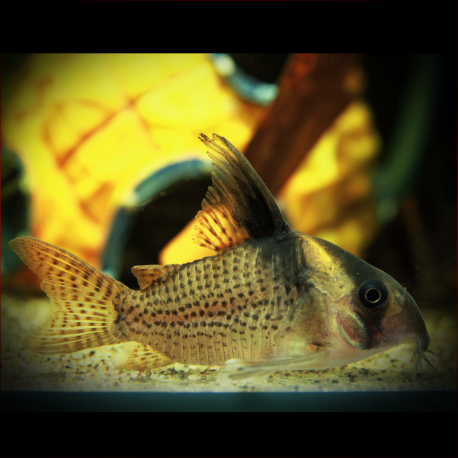More info
Datasheet
| Maximum Size | 6.0cm / 2.36inches |
| Temperature | 20°C / 68.00°F - 26°C / 78.80°F |
| Hardness | 2.02dgH / 36ppm - 12.05dgH / 215ppm |
| pH | 6.0-7.5 |
General Description
The Spotted Cory (Corydoras Brevirostris) belongs to the Callichthyidae family, is one of many similar species difficult to differentiate, typically recognized by its relatively short, rounded snout and dark bars in the caudal fin. As part of the armored catfish group, they feature bony plates on their bodies instead of scales and belong to the Siluriformes order. These foraging omnivores are known for their facultative air-breathing ability and modified intestine for survival in low-oxygen environments.
Aquarium Setup
To successfully house Spotted Corydoras, it is recommended to keep them in groups of 4-6 individuals. The ideal tank setup includes a substrate of fine sand or clean rounded gravel, with additional decor such as plants or driftwood for cover. Water conditions should maintain a hardness of 36-215ppm, a pH range of 6.0-7.5, and a temperature between 20-26°C (see table).
Behaviour
Spotted Corydoras exhibit peaceful and gregarious behavior, thriving when kept in a group setting. Being facultative air breathers, they may occasionally rise to the water's surface to gulp air. However, caution is advised as their stiffened pectoral-fin spines can cause painful injuries, and there are suggestions that secretions from their axillary glands might be mildly toxic or venomous.
Feeding and Diet
In captivity, these omnivorous fish readily accept sinking dried foods, live, and frozen varieties such as bloodworms and Tubifex. A diverse diet ensures their well-being, as they should not rely on leftovers from other aquarium inhabitants. Maintaining a varied diet will help keep the Spotted Cory in optimal health.
Reproduction & Dimorphism
Sexual dimorphism in Spotted Corydoras is noticeable, with females growing larger and having a rounder, higher-bodied appearance than males. Details on their reproductive behavior and specific dimorphic features are not provided in the available information.
Habitat and Distribution
Described initially from a specimen exported from the Río Orinoco drainage in Venezuela, the exact distribution of Corydoras Brevirostris is somewhat uncertain but typically includes the Orinoco system and unnamed coastal rivers in Suriname. It is likely that these fish also inhabit rivers in Guyana, showcasing a disjunct distribution pattern.

